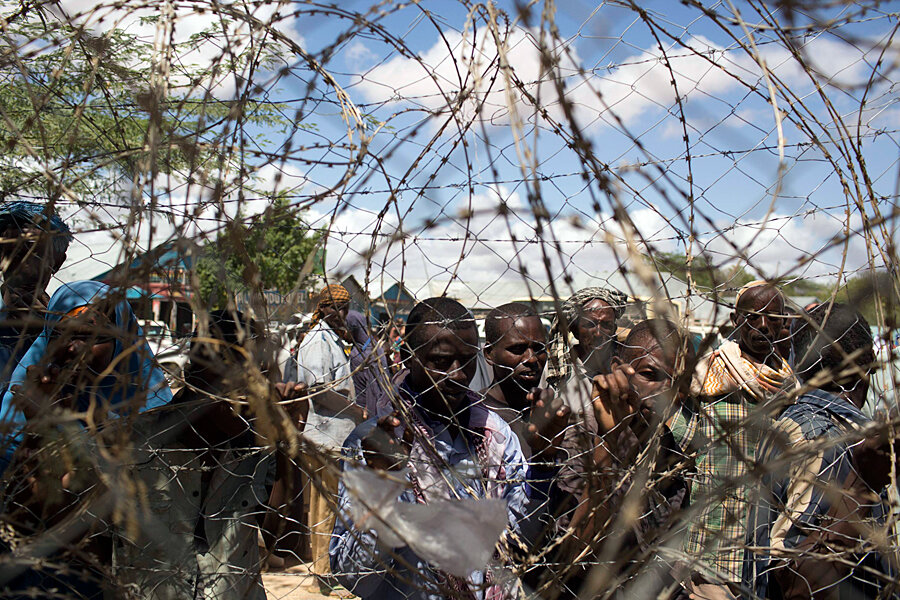Long at home in Kenya, Somali refugees feel pressure to leave
| Nairobi, Kenya
In the aftermath of the Westgate Mall massacre carried out here by Al Shabab radicals based in Somalia, the Kenyan government and public are increasingly pointing to Kenya's large Somali war-refugee population as a problem to be solved sooner rather than later.
On Nov. 10, in the first repatriation agreement of its kind, Kenya, Somalia, and the United Nations signed a tripartite pact that urges hundreds of thousands of refugees to return to their war-torn country after decades in exile.
In the suburb of Eastleigh here, known as “Little Mogadishu” for its concentration of ethnic Somalis, more and more refugees are dreading a rising chorus in Kenya about national security that they think will end in forcing them out of the large camps and the Kenyan urban neighborhoods where they reside.
The exact number of Somali refugees is unclear, with the UNHCR registering more than 480,000, but analysts estimate the figure may be twice that.
For example, more than 500,000 Somali refugees live in Dadaab camp in Kenya's northeast, making it ostensibly the world’s biggest refugee settlement. The camp is the size of Nakuru, Kenya’s third-largest city.
In Little Mogadishu, news about the agreement hit hard, with many Somali's saying the handwriting of their departure is starting to appear on the wall. Many interviewed say it is not possible to go back home since the violence they fled still persists – and there is no guarantee of security, not to mention food, education, and medical care in Somalia.
"I am not going back to Somalia at any costs," says Amina Mohammed, a mother of five who speaks from her tiny space in Eastleigh. "I would rather spend all my life in prison. This is a very hard option for the refugee families, many who are poor.”
The new agreement does not offer a formal start date. But some local Kenyan agencies have welcomed it as a step toward solving the controversial Somali refugee presence here.
Some international NGOs have weighed in, including the International Rescue Committee and the Danish Refugee Council, saying the current security context in Somalia is not safe for any mass return of refugees.
“Today, only few pockets of Somalia are safe for return,” they said Nov.13 in a collective statement.
Somalis' concern over the repatriation pact follows strong anti-Somali political comment favoring their expulsion in the wake of the Westgate attack Sept. 21. Kenyan authorities accused refugees and Somali migrants of aiding Al-Shabab militants in the killing of 67 people at the posh mall on a sleepy Saturday morning – a siege that galvanized world attention.
Since then, emotions in Kenya have heightened with the Somali community being sometimes directly and sometimes subtly accused of aiding perpetrators of the deadly attack and with complicity in other such cases.
In Eastleigh, refugees and migrants have helped transform the area into one of East Africa’s leading commercial zones. The once shabby and dusty neighborhood has bustling shopping malls, hotels, and markets.
That has often been forgotten as the refugee's stay seems controversial. “When I came here I was a little girl, I didn’t have children," says Ms. Mohammed. "Now I have five, all born in Kenya. They would not get the same education, lifestyle, and care they find here in Nairobi. They are all Kenyans and the authorities have no right to ask me to take them to Somalia,” she adds, showing a card she has just used to pay city council fees.
For Mr. Ali Abdul, a refugee managing large clothing shop, many refugees cannot help being guarded since agreement had followed calls for the closure of the camps and expulsion of urban refugees.
“I am suspicious that they only want us out, but Somalia is still very insecure. I don’t see many refugees choosing to go back there,” says Abdul, who arrived in Nairobi two years ago from the Dadaab camp.
He says most refugees have no links to Al Shabab and only want to run small businesses to survive. In another shopping zone, Ahmad Abdullahi agrees with Abdul that most refugees are innocent, while urging Kenya to grant citizenship to those who have lived here for long.
“There could be few collaborators, most of us are innocent. We even have families with Kenyan citizens. We are also contributing to the economy. Are they not being inhuman when they ask to leave now?” he asks as he sells shoes.
Mohammed Abdi, a refugee who owns a mobile phone shop, wants to remind Kenyans that Al Shabab still controls three counties in southern Somalia, the same place where many of the current Somali refugees escaped from.
“There is some progress toward peace, but we don’t want to go back, as everyone is saying. For now, we feel the Kenya government is forcing us to go to a war zone,” says Mr. Abdi.






